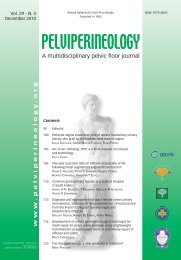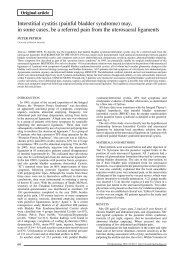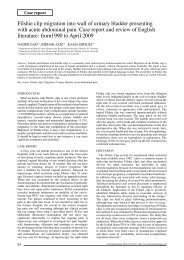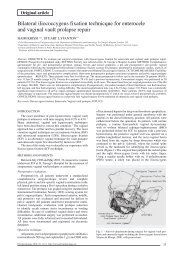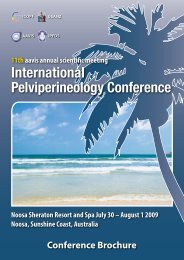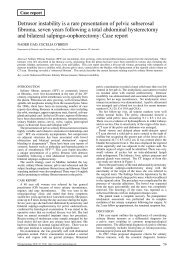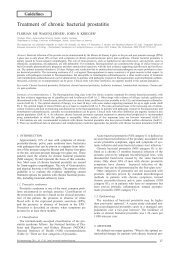This Issue Complete PDF - Pelviperineology
This Issue Complete PDF - Pelviperineology
This Issue Complete PDF - Pelviperineology
You also want an ePaper? Increase the reach of your titles
YUMPU automatically turns print PDFs into web optimized ePapers that Google loves.
A simple technique for intravesical tape removal<br />
REFERENCES<br />
1. Rezapour M, Ulmsten U. Tension-free vaginal tape (TVT) in<br />
women with recurrent stress urinary incontinence - a long-term<br />
follow-up. Int Urogynaecol J Pelvic Floor Dysfunct 2001; 12<br />
Suppl 2: S9-11.<br />
2. Haab F, Sananes S, Amarenco G, Ciofu C, Uzan S, Gattegno<br />
B, Thibault P. Results of the tension-free vaginal tape procedure<br />
for the treatment of type II stress urinary incontinence at a<br />
minimum follow-up of 1 year. J Urol 2001; 165: 159-62.<br />
3. Kuuva N, Nilsson CG. A nationwide analysis of complications<br />
associated with the tension-free vaginal tape (TVT) procedure.<br />
Acta Obstet Gynecol Scand 2002; 81: 72.<br />
4. Ward KL, Hilton P, Browning J. A randomised trial of colposuspension<br />
and tension free vaginal tape for primary genuine<br />
stress incontinence. Neurourol Urodyn 2000; 19: 386.<br />
5. Sweat SD, Itano NB, Clemens JQ, et al. Polypropylene mesh<br />
tape for stress urinary incontinence: complications of urethral<br />
erosion and outlet obstruction. J Urol. 2002; 168: 144-146.<br />
6. Madjar S, Tchetgen MB, Van Antwerp A, et al.Urethral erosion<br />
of tension-free vaginal tape. Urology 2002; 59: 601.<br />
7. Pit MJ: Rare complications of tension-free vaginal tape procedure:<br />
late intraurethral displacement and early misplacement of<br />
tape. J Urol 2002; 167: 647.<br />
8. Volkmer BG, Nesslauer T, Rinnab L, et al. Surgical intervention<br />
for complications of the tension-free vaginal tape procedure.<br />
J Urol 2003; 169: 570-574.<br />
9. Jorion JL. Endoscopic treatment of bladder perforation after<br />
tension-free vaginal tape procedure. J Urol 2002; 168: 197.<br />
10. Baracat F, Mitre AI, Kanashiro H, et al. NI. Clinics 2005; 60:<br />
397-400.<br />
11. Kielb S, Clemens J. Endoscopic excision of intravesical tension-free<br />
vaginal tape with laparoscopic instrument assistance<br />
J Urol 2004; 172: 971.<br />
12. Giri SK, Drumm J, Flood HD. Holmium laser excision of intravesical<br />
tension-free vaginal tape and polypropylene suture after<br />
anti-incontinence procedures. J Urol 2005; 174: 1306-7.<br />
13. Hodroff M, Portis A, Siegel SW. Endoscopic removal of intravesical<br />
polypropylene sling with the holmium laser. J Urol<br />
2004; 172: 1361-2.<br />
Correspondence to:<br />
STAVROS N. CHARALAMBOUS MD PhD FEBU<br />
Urological Surgeon<br />
Vice-Director of Urological Department<br />
Hippokratio General Hospital<br />
49 Kostantinoupoleos str<br />
55236, Thessaloniki, Greece<br />
Tel. +3023 10892307 - Fax +2310 30 826666<br />
E-mail: st.charalambous@gmail.com<br />
Pelvic Floor Digest<br />
continued from page 25<br />
7 – PAIN<br />
Comparative measurement of pelvic floor pain sensitivity in chronic pelvic pain. Tu FF, Fitzgerald CM, Kuiken T et al. Obstet Gynecol.<br />
2007;110:1244. Women with pelvic pain conditions exhibit enhanced somatic pain sensitivity at extragenital sites. Whether comparable differences<br />
exist for pelvic floor or vaginal pain sensitivity is unknown. Comparing 14 women with chronic pelvic pain to 30 healthy women without this<br />
condition and using a prototype vaginal pressure algometer, we recorded continuous ascending pressure and determined each subject’s pressurepain<br />
threshold at each of eight paired pelvic floor sites and two adjacent vaginal sites. Thresholds were significantly lower in women with pelvic<br />
pain (at iliococcygeus). Pelvic floor and vaginal site pain detection thresholds had moderate-to-strong correlations with each other.<br />
Re-imagining interstitial cystitis. Hanno PM. Urol Clin North Am. 2008;35:91. An “antiproliferative factor” has been postulated in the<br />
etiologic pathway of the painful bladder syndrome/interstitial cystitis, but without any dramatic breakthroughs in the field. Other looks with<br />
regard to epidemiology, etiology, and clinical treatment are being taken.<br />
Chronic prostatitis/chronic pelvic pain syndrome. Pontari MA. Urol Clin North Am. 2008;35:81. Prostatitis is not any more referred to<br />
inflammation in the prostate, often attributed to an infection, but rather to a chronic pain syndrome for which the presence of inflammation and<br />
involvement of the prostate are not always certain. The article discusses this syndrome and the various factors associated with diagnosis and<br />
treatment.<br />
Vulvodynia: new thoughts on a devastating condition. Gunter J. Obstet Gynecol Surv. 2007;62:812. The article explores 3 factors that<br />
may contribute to inconsistent results with therapy; the hypothesis that vulvodynia is a systemic disorder; the idea that failure to address the<br />
psychological or emotional aspect or chronic pain may affect outcome; and the concept that chronic vulvar pain, like headache, is not a single<br />
condition but is a diverse group of disorders that produce the same symptom.<br />
Vulvodynia: case report and review of literature. Gumus II, Sarifakioglu E, Uslu H, Turhan NO. Gynecol Obstet Invest. 2007;65:155.<br />
Vulvodynia is a chronic pain syndrome affecting up to 18% of the female population, defined as chronic vulvar burning, stinging, rawness,<br />
soreness or pain in the absence of objective clinical or laboratory findings. A case accompanying somatoform disorder and depression is<br />
presented.<br />
Painful bladder syndrome/interstitial cystitis and vulvodynia: a clinical correlation. Peters K, Girdler B, Carrico D et al. Int Urogynecol<br />
J Pelvic Floor Dysfunct. 2007 Nov 24; epub. Vulvodynia affects 25% of women with painful bladder syndrome/interstitial cystitis (PBS/IC).<br />
To clinically evaluate the association of PBS/IC and vulvodynia and possible contributing factors, a group of 70 women were divided in 2<br />
subgroups with and without vulvodynia for comparison. Average levator pain levels were significantly greater in those with vulvodynia and<br />
there were no differences in number of pelvic surgeries, sexually transmitted infections, vaginitis or abuse history.<br />
Serum paraoxonase-1 activity in women with endometriosis and its relationship with the stage of the disease. Verit FF, Erel O, Celik N.<br />
Hum Reprod. 2007 Nov 13; epub. Oxidative stress may play a role in the pathophysiology of endometriosis. Serum paraoxonase-1 (PON-1) is<br />
a high-density lipoprotein (HDL) associated enzyme that prevents oxidative modification of low-density lipoprotein (LDL). The serum PON-1<br />
activity in women with endometriosis was significantly lower compared to controls and a negative correlation was found with the stage of the<br />
disease.<br />
8 – FISTULAE<br />
Limited anterior cystotomy: a useful alternative to the vaginal approach for vesicovaginal fistula repair. Hellenthal NJ, Nanigian<br />
DK, Ambert L, Stone AR. Urology. 2007;70:797. Most vesicovaginal fistulas are corrected using a transvaginal approach. A novel abdominal<br />
approach is described, using a small anterior cystotomy and omental pedicle interposition.<br />
The PFD continues on page 30<br />
27



